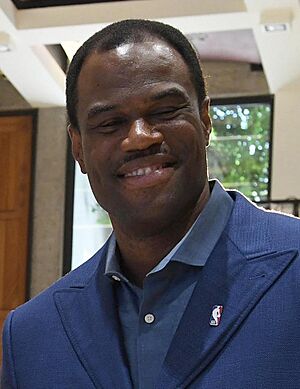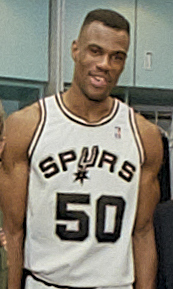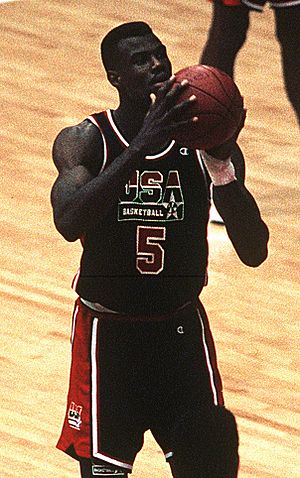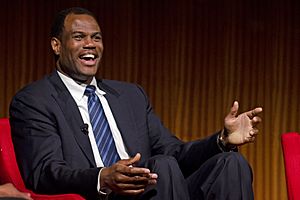David Robinson facts for kids

Robinson in 2017
|
||||||||||||||||||||||||||||||||||||||
| Personal information | ||||||||||||||||||||||||||||||||||||||
|---|---|---|---|---|---|---|---|---|---|---|---|---|---|---|---|---|---|---|---|---|---|---|---|---|---|---|---|---|---|---|---|---|---|---|---|---|---|---|
| Born | August 6, 1965 Key West, Florida, U.S. |
|||||||||||||||||||||||||||||||||||||
| High school | Osbourn Park (Manassas, Virginia) | |||||||||||||||||||||||||||||||||||||
| Listed height | 7 ft 1 in (2.16 m) | |||||||||||||||||||||||||||||||||||||
| Listed weight | 250 lb (113 kg) | |||||||||||||||||||||||||||||||||||||
| Career information | ||||||||||||||||||||||||||||||||||||||
| College | Navy (1983–1987) | |||||||||||||||||||||||||||||||||||||
| NBA Draft | 1987 / Round: 1 / Pick: 1st overall | |||||||||||||||||||||||||||||||||||||
| Selected by the San Antonio Spurs | ||||||||||||||||||||||||||||||||||||||
| Pro career | 1989–2003 | |||||||||||||||||||||||||||||||||||||
| Career history | ||||||||||||||||||||||||||||||||||||||
| 1989–2003 | San Antonio Spurs | |||||||||||||||||||||||||||||||||||||
| Career highlights and awards | ||||||||||||||||||||||||||||||||||||||
|
||||||||||||||||||||||||||||||||||||||
| Career NBA statistics | ||||||||||||||||||||||||||||||||||||||
| Points | 20,790 (21.1 ppg) | |||||||||||||||||||||||||||||||||||||
| Rebounds | 10,497 (10.6 rpg) | |||||||||||||||||||||||||||||||||||||
| Blocks | 2,954 (3.0 bpg) | |||||||||||||||||||||||||||||||||||||
|
Medals
|
||||||||||||||||||||||||||||||||||||||
David Maurice Robinson (born August 6, 1965) is a famous American former professional basketball player. He played for the San Antonio Spurs in the National Basketball Association (NBA) from 1989 to 2003. He was nicknamed "the Admiral" because he served in the U.S. Navy.
Robinson was an amazing player, chosen for the NBA All-Star team 10 times. He was the NBA MVP in 1995 and helped his team win two NBA championships (in 1999 and 2003). He also won two Olympic Gold Medals with the U.S. team in 1992 and 1996. Many people think he is one of the best centers in basketball history.
Contents
Early Life and Education
David Robinson was born in Key West, Florida. His family moved a lot because his father was in the U.S. Navy. After his father retired, they settled in Woodbridge, Virginia. David was a great student and good at many sports, but not basketball at first.
He went to Osbourn Park High School in Manassas, Virginia. For most of his childhood, David was an average height. In his junior year of high school, he was about 5 feet 9 inches tall. But in his senior year, he had a huge growth spurt and grew to 6 feet 6 inches! He hadn't played organized basketball before, but the school coach added him to the team.
After high school, David scored very well on the SAT test. He decided to go to the United States Naval Academy. He studied mathematics and played on the basketball team. The Naval Academy usually had a height limit of 6 feet 6 inches. But David kept growing, and by his second year, he was almost his adult height of 7 feet 1 inch. This meant he couldn't serve on Navy ships later.
In 2011, Robinson earned a Master's degree. He wanted to learn more about how businesses work.
David Robinson is known as the best basketball player in the history of the Naval Academy. He chose jersey number 50 because his hero was Ralph Sampson. When he started college, he didn't expect to play in the NBA. But in his last two years, he became a top college player. He won the most important college player awards, like the Naismith and Wooden Awards.
In 1986, Robinson led Navy's team close to the Final Four in the NCAA tournament. After graduating, he was chosen by the San Antonio Spurs as the first pick in the 1987 NBA draft. However, the Spurs had to wait two years for him. This was because he had to complete his active duty service with the Navy.
Robinson thought about leaving the academy earlier. But he decided to stay after learning that his height might stop him from serving at sea. As a compromise, he became a civil engineering officer. He served for two years at the Naval Submarine Base Kings Bay in Georgia. Even though he was called "Admiral," his highest rank was lieutenant (junior grade).
Professional Basketball Career
Becoming a Star (1989–1994)
After his Navy service, David Robinson joined the San Antonio Spurs for the 1989–90 season. The Spurs had been a struggling team. But with Robinson, they had an amazing turnaround. They improved their record by 35 wins, which was a huge jump!
Robinson was named the NBA Rookie of the Year. He also helped the Spurs make the playoffs for seven years in a row. In the 1991–92 season, he led the league in blocks. He was named the NBA Defensive Player of the Year.
Robinson was also part of the famous 1992 US Olympic Dream Team. This team won the gold medal in Barcelona. In the 1993–94 season, he had an incredible game. He scored 71 points against the Los Angeles Clippers to win the NBA scoring title. That season, he averaged almost 30 points per game!
MVP and Challenges (1994–1998)
In 1995, Robinson won the MVP award. In 1996, he was named one of the 50 Greatest Players in NBA History. But he still hadn't won an NBA championship. The Spurs were often eliminated from the playoffs by other strong teams. One tough loss was against Hakeem Olajuwon and the Houston Rockets. Robinson admitted that Olajuwon outplayed him in that series.
In the 1996–97 season, Robinson faced a big challenge. He hurt his back and then broke his foot, missing most of the season. Because of his injury and other players being hurt, the Spurs had a very bad record. However, this turned out to be a good thing. The Spurs won the NBA Draft Lottery and got the first pick in the next draft. They used it to choose Tim Duncan. Duncan became the missing piece for Robinson to finally win an NBA title.
Championship Years (1998–2003)
Robinson's later career had some back problems. Before the 1998–99 season, there was a lockout, which meant no games were played for a while. When the season finally started, it was shorter. The Spurs had the best record in the NBA.
In the playoffs, the Spurs were unstoppable. They reached the NBA Finals for the first time ever. David Robinson and Tim Duncan were called "The Twin Towers" because they were both tall and powerful. They beat the New York Knicks in five games to win the NBA championship! It was the first time a former American Basketball Association team won an NBA title. Duncan was named the Finals MVP.
Robinson announced he would retire after the 2002–03 season. On June 15, 2003, in his very last game, the Spurs won another NBA title. They beat the New Jersey Nets in Game 6 of the 2003 NBA Finals. Robinson scored 13 points and grabbed 17 rebounds in that final game. He and Tim Duncan were named Sports Illustrated Sportsmen of the Year for 2003.
Player Skills
David Robinson was an amazing basketball player. He was very mobile and fast for a center. He had great hands for both offense and defense. He could dunk the ball easily and block many shots. He was also good at shooting from mid-range.
Throughout his NBA career, Robinson averaged 21.1 points, 10.7 rebounds, 3 blocks, and 2.5 assists per game. He is one of only a few players to score over 20,000 points in the NBA. He is also one of only four players to ever record a quadruple-double. This means he had double-digit numbers in four different stats in one game (points, rebounds, assists, and blocks). He achieved this with 34 points, 10 rebounds, 10 assists, and 10 blocks in 1994.
Robinson is also one of only ten players to score 70 or more points in a single game. He scored 71 points against the Los Angeles Clippers in 1994.
He was also known for his great relationship with Tim Duncan. Many people noted that Robinson welcomed and helped Duncan, even reducing his own role to let the younger star shine. In 2022, The Athletic ranked Robinson as the 20th greatest player in NBA history.
National Team Career
David Robinson played for the United States national team many times. He won gold medals at the 1986 FIBA World Championship, 1992 Summer Olympics, and 1996 Summer Olympics. He also won a silver medal at the 1987 Pan American Games and a bronze medal at the 1988 Summer Olympics.
Other Activities
In 2001, Robinson started and funded the Carver Academy in San Antonio. This was a non-profit private school to help children in the inner city. In 2012, it became a public charter school called IDEA Carver. Robinson is still very involved in the school.
In 2008, Robinson started Admiral Capital Group. This company invests in businesses that can also help the community. Robinson wanted to create more financial support for The Carver Academy. He also co-owns a car dealership.
Personal Life
David Robinson married Valerie Hoggatt in 1991. They have three sons: David Jr., Corey, and Justin. His son Corey played football at Notre Dame. His son Justin played basketball at Duke University and later became a professional basketball player in Montenegro.
David Robinson became a Christian in 1991.
Awards and Honors
NBA
- 2× NBA champion (1999, 2003)
- NBA Most Valuable Player (1995)
- NBA Defensive Player of the Year (1992)
- 10× NBA All-Star (1990–1996, 1998, 2000, 2001)
- NBA Rookie of the Year (1990)
- NBA scoring champion (1994)
- NBA rebounding leader (1991)
- NBA blocks leader (1992)
- No. 50 retired by San Antonio Spurs
USA Basketball
- 2× Olympic Gold Medal (1992, 1996)
- 1988 Olympic Bronze Medal
- 1986 FIBA World Championship Gold Medal
NCAA (College)
- Consensus National college player of the year (1987)
- NCAA rebounding leader (1986)
- 2× NCAA blocks leader (1986, 1987)
Halls of Fame
- 2× Naismith Basketball Hall of Fame (2009, 2010)
- 2× U.S. Olympic Hall of Fame (2008, 2009)
- 2× FIBA Hall of Fame (2013, 2017)
Media
- 2003 Sports Illustrated Sportsman of the Year
Charitable Work
David Robinson is also well-known for his charity work. In 1991, he promised fifth-graders at a school in San Antonio a $2,000 scholarship if they finished school and went to college. In 1998, he gave $8,000 to each student who completed his challenge.
He and his wife, Valerie, founded the Carver Academy in San Antonio, which opened in 2001. They have given more than $11 million to the school.
In 2003, the NBA renamed its award for great charitable efforts after Robinson. Winners of the NBA's Community Assist Award receive the David Robinson Plaque. This award is given monthly to players for their charity work.
See also
 In Spanish: David Robinson para niños
In Spanish: David Robinson para niños




